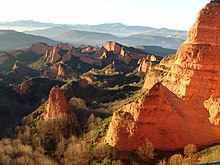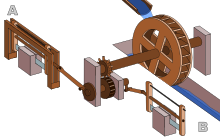Mining in ancient Rome

Mining in ancient Rome utilized hydraulic mining and shaft mining techniques in combination with equipment such as the Archimedes screw. The materials they produced were used to craft pipes or construct buildings. Quarries were often built through trial trenching and they used tools such as wedges to break the rock apart, which would then be transported using cairns and slipways. Mines typically used slaves and lower-class individuals to extract and process ore. Usually their working conditions were dangerous and inhumane, resulting in frequent accidents and even suicidal ideation. These areas were divided into districts and were regulated by several laws such as the lex metalli vispascensis.
Technology

Hydraulic mining
The Romans used a technique known as hushing, which is a method of hydraulic mining that uses water to erode the rock.[1] This would be accomplished by using holes to funnel water into the area, thus breaking it up. The water was supplied to the area through aqueducts,[2] it would then be stored in a tank, which would flood the area when opened. Following this process, fire was used to heat the rock, which was subsequently quenched with water, thus cracking the rock through thermal shock.[3] The Romans also used ground sluicing, which is the use of tunneling equipment or excavation equipment to mine stream beds.[4][5][6]
Shaft sinking
Shaft sinking was the most dangerous and most difficult form of mining in ancient Rome. Due to its high cost, it was only used to collect the most valuable metals in Roman society. This technique involved digging tunnels underground, allowing workers to extract the ore. Access to these mines and tunnels was provided by shafts which were usually around 3–6 square feet (0.28–0.56 m2) and lined with wood. They also served as ventilation. Roman mines were notorious for their poor ventilation systems. Poisonous gasses often poured into the mines, and noxious air was common in silver mines.[7][6]
Underground mining

Surface mining and strip mining
Surface mining was used by the ancient Romans when the rock embedded in the surface was visible. They used the technique of panning on areas where a stream had eroded the rock. Pliny wrote that this technique was useful for finding the purest form of gold. It was also useful for finding ore veins that lead back to the ground or the mountains and for small mining operations. The Romans also used strip mining, they would remove the exposed ore from a hill. They would do this by using water to remove the soil and matter.[6]

Tools
Ancient Roman miners used double-sided hammers, broad sided pickaxes,[11] and picks that were usually made of iron.[12][13][14] Child laborers in ancient mines possibly carried baskets that were used to transport materials.[13] Another tool used by miners was the dolabra fossoria, which was capable of being used as a pickaxe or as a mattock.[15][16] Miners also wore heavy belts to carry their tools and materials.[17][6]
Materials and usage
Lead

Roman mines supplied the empire with its currency. The production of currency was correlated with a significantly increased amount of lead. During periods of stability and high coin production, there was a high amount of lead production. However, during periods of crisis, such as the fall of the Roman Republic there was a decreased rate of coin production, and therefore a reduced rate of lead production.[18][19] Lead was also used to make water pipes and bullae.[20][21][22] The high amounts of lead in ancient Rome led to concurrently high amounts of lead poisoning.[23][24][6]
Metals and stone
Metals were used as a medicine for diseases such as sarcomas, rashes, and leprosy. They could also be used as a deodorant. Alumen was a liquid substance used to bind dyes to fabrics, making it one of the most popular and effective tools for painting.[25][26] Roman surgeons also applied alum to wounds to heal them.[27][28] This method worked because it would dry the wounds and draw the tissues together, allowing them to heal easier.[29] Aluminum was also mixed with water to create cement.[30] Most stone was produced locally as it was typically expensive to transport.[31] According to the writer Vitruvius Roman quarries produced many varieties of stone, including red and black tufa, as well as white or soft stone.[32] The material quarries produced was used in construction.[33][34][6]
Types
Quarries


The Romans usually built quarries near the seas or rivers.[31][35] Upon finding an adequate place for a quarry, the rock was withered away, usually through trial trenching. Afterwards, a line of holes would be chiseled into the rock surface, and wedges would proceed to be inserted into these holes, which were then used to pull the rock apart. The workers would proceed to shape the area with stone blocks. Ancient Roman quarries used stone cairns to supply the material necessary for slipway ramps, which were used to access the quarry and carry out the mined material. Cranes may have also been used to drag material out of quarries. Camels, donkeys, wagons, or ships may have been used as work animals to assist the miner's efforts. The workers may have slept, relaxed, and possibly lived in huts that were placed by the quarries. One quarry has a village of 16 huts, 15 of which are organized in a circle. Another quarry used an L-shaped building with many rooms, and 5 multi-room sections. This building likely served as a dining area and a social area for the workers and administrators of the quarry. Some quarries had watchtowers, which were likely used for long-distance communication or to watch over the labor of prisoners. Forts, temples, baths, and cemeteries were present in the quarry at Wadi Abu Ma'amel. In this quarry, the slipway routes ended in a flat pedestal, and chippings of black porphyry covered the loading ramp.[6]
Mines
Administration
During the Roman Empire mines and quarries were organized into districts. They were governed by the lex metallis dicta, a law that dictated the rules and regulations of the mines and the punishments for violating them. Slaves who had stolen ore were flogged and prohibited from continuing to work in the mines, freedmen had their property confiscated and lost the privilege of working in the mines. In the case of sabotage, both groups would be banned from the mines. The lex metalli vispascensis, another law governing the mines allows for the collection of fees and gives certain groups the ability to monopolize their industry. Toll stations may have been placed around mining sites to mark their borders, collect fines, and manage the traffic and trade in the mine.[6]
See also
References
- ISBN 978-0-470-48786-0.
- ISBN 978-1-59433-709-3.
- ^ "Mining". Romans in Britain. Archived from the original on 19 June 2008. Retrieved 23 July 2022.
- ISBN 978-1-107-49556-2.
- ISBN 978-1-9822-5675-3.
- ^ ISBN 978-0-19-957287-8.
- ISBN 978-1-4408-2908-6.
- ISBN 978-0-12-821538-8.
- ^ Reden 2021, p. 401-404.
- ^ Environmental Health Perspectives. U.S. Department of Health, Education, and Welfare, Public Health Service, National Institutes of Health, National Institute of Environmental Health Sciences. 2001.
- ISBN 978-0-674-41653-6.
- ISBN 978-1-4214-1212-2.
- ^ ISBN 978-1-78297-936-4.
- ISBN 978-1-4214-1210-8.
- ISBN 978-1-4408-2908-6.
- ^ Cowan, Ross (Nov 2021). "Tales of the Axe". Ancient Warfare Magazine. 15/2: 9
- ISBN 978-1-4456-8422-2.
- ISBN 978-3-11-060493-1.
- ISBN 978-3-319-58760-8.
- ISBN 978-1-350-19646-9.
- ISBN 978-1-4987-1494-5.
- ISBN 978-0-7440-2122-6.
- ISBN 978-3-030-64888-6.
- ISBN 978-1-61069-620-3.
- ISBN 978-88-7814-990-8.
- ISBN 978-1-60606-325-5.
- ISBN 978-1-4042-0705-9.
- ISBN 978-0-7660-9902-9.
- ISBN 978-0-7614-0947-2.
- ISBN 978-0-429-59119-8.
- ^ ISBN 978-0-8160-7482-2.
- ISBN 978-1-60606-016-2.
- ISBN 978-94-015-7795-3.
- ISBN 978-1-78701-237-0.
- ISBN 978-0-8078-3480-0.
- ISBN 978-1-351-18809-8.
- ISBN 978-90-04-44349-5.
- ISBN 978-0-7818-1153-8.
- ISBN 978-1-58510-796-4.
- ISBN 978-1-136-76143-0.
- ISBN 978-1-4034-0518-0.
- ISBN 978-0-521-89746-4.
